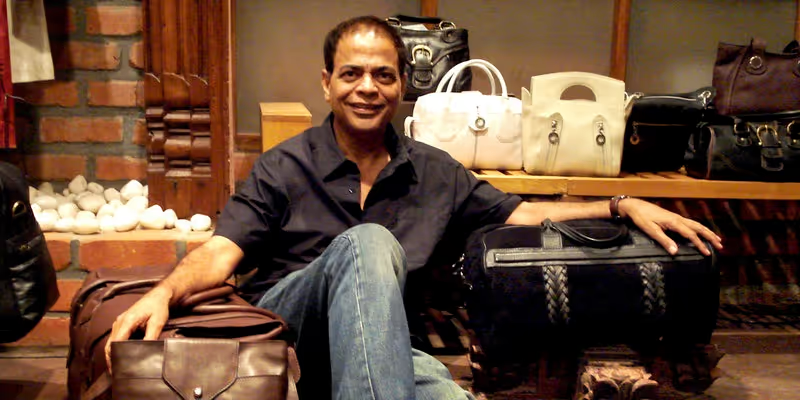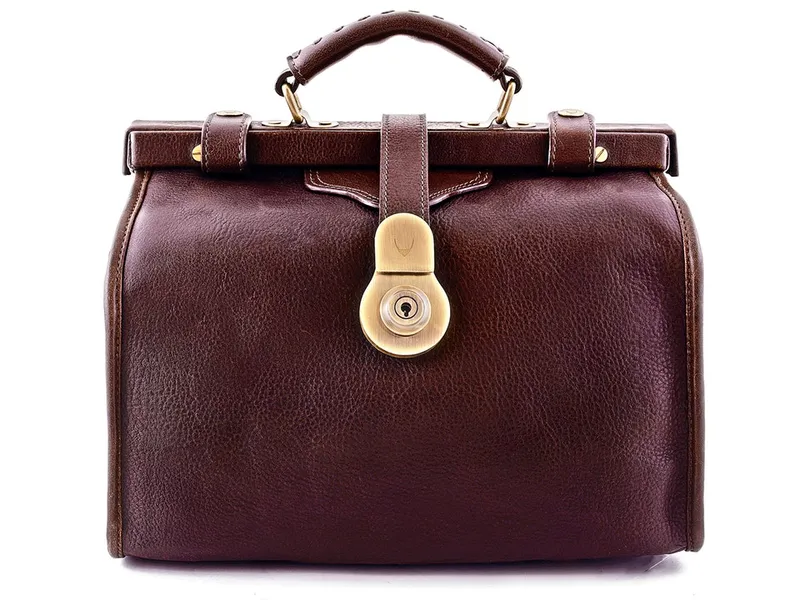With Rs 25k and one cobbler, this entrepreneur built a Rs 170 Cr leather bags brand out of Puducherry
Leather bags and accessories brand Hidesign started as a small, artisan workshop in Puducherry. Today, it has grown into a lifestyle business with a presence in hundreds of exclusive stores, airport stores, shop-in-shops, multi-brand outlets, and ecommerce platforms.

Hidesign founder Dilip Kapur
For a long time, Dilip Kapur thought international affairs was his calling. He moved from Pondicherry (now Puducherry), to the US to do a PhD in international affairs.
But life had other things in store for him. While doing a part-time job at a leather factory, Dilip fell in love with leather.
After completing his studies and returning to Puducherry, Dilip started making leather bags as a hobby. His time at the factory taught him all he needed to know about making leather bags. Dilip started sourcing leather from Chennai and started making hand-crafted leather bags in Auroville.
“The short stint at the leather factory made leather my lifelong passion. However, designing and making leather bags did not make me a businessman. I didn’t even know how to read a profit and loss statement at that point of time,” he tells SMBStory.
But he wasn’t about to let this dampen his entrepreneurial spirit. Dilip gathered Rs 25,000, hired one cobbler, and started a two-person artisan workshop named Hidesign.
“Hidesign was born out of the need to be different from the uniform and synthetic flatness of leather bags in the mass market. It was almost like making strong my aversion towards painted leathers that didn’t look natural at all,” he says.
Dilip’s rebellion against mass production meant his first market was small alternative stores in the US, the UK and Australia. The general public was still buying uniform, mass-produced leather products from mainstream stores.
The freedom to design the kind of leather bags he wanted to was enough to give Dilip satisfaction. Hence, he ran the business in a small capacity.

Hidesign founder Dilip Kumar
Scaling up
Dilip’s wakeup call came in the form of a German tourist who visited Puducherry. The tourist, impressed by Dilip’s work, said he wanted 1,400 bags.
Dilip’s eyes nearly popped out, but he agreed to accept the huge order. With just one cobbler and a single sewing machine, Dilip worked tirelessly to make 200 bags in just six months.
“That was a huge challenge and I had almost given it all up. But many others who visited Auroville showed interest in my leather bags and took them abroad, hence popularising Hidesign brand. This turned my passion into a full-fledged brand,” he says.
Dilip also started making wallets and computer bags under his brand.
In 1984, Hidesign entered its first departmental store, John Lewis, in the UK, where its entire range was stocked. Cracking John Lewis signified the brand’s shift from an edgy, alternative brand to a commercial and mainstream one.
By 1988, Hidesign had ventured into garments, with leather jackets and long pants. The UK market couldn’t get enough of Dilip’s leather bags. Hidesign was soon present across 700 stores in London.
“In 1990, we set up a factory in Puducherry, but were still not ready to enter the Indian market. It took another nine years to finally open the first few Hidesign stores in India,” he says.
Over the next few years, Dilip opened another production unit in Puducherry, and one in Sikkim. He also set up a tannery in Chennai.
“At the Chennai unit, we treat leather to stop it from decomposing so that it serves for a long time. This prevents it from becoming a health and hygiene problem. We follow traditional process of vegetable tanning for preservation of leather by using plant matter like tree bark and seeds,” he says.
Dilip did not believe in grain correction or painting leather. He wanted to celebrate the natural texture and grain of leather, which was part of his ethos from the beginning.
The natural and ecological tanning process enhances the intrinsic characteristics and individuality of Hidesign’s leathers, lending it strength and durability.
“The effluents released in the tanning process go through an RO filtration system. The water after filtration is of drinkable quality, and is re-used in the tannery for the next cycle of the tanning process,” he explains.

Hidesign's Grazia original leather bag from 1981
“Further, Hidesign's solid brass buckles are individually sand cast and hand polished, reflecting old saddlery traditions. The solid brass buckles and fittings enhance the natural look of our product and also makes the product durable,” Dilip says.
Presently, Hidesign buys raw leather locally as well as from Uganda, Spain, New Zealand, and Brazil. After tanning in Chennai, manufacturing is done in Hidesign’s units in Pondicherry and Sikkim.
Business focus
Dilip’s company now clocks Rs 170 crore gross annual revenue and has 1,400 employees. It has evolved from a leather goods maker into a lifestyle brand with presence in exclusive stores, airport stores, shop-in-shops, multi-brand outlets, and ecommerce platforms. It claims presence in 102 exclusive brand outlets and 112 large format departmental stores.
Hidesign’s product portfolio comprises ladies’ bags, men’s bags, wallets, belts, shoes, sunglasses, luggage, and jackets. The ladies’ bags and men’s bags are its top sellers.
“Accessories have evolved from being functional to making a fashion statement. The demand for accessories is not only from women, but also from a large section of men who no longer want to look sloppy. With the increase in demand, we diversified our product range. We added leather-lined footwear, natural acetate and leather sunglasses as well as a range of stationery products,” Dilip says.
The leather bags are priced-based on a cost price multiplier formula and the MRPs are competitive, he adds. Hidesign does not do perception pricing or follow a discount-led pricing model. Its products rarely go on discount, except during end of season sales when it wants to clear its stock of slow-moving products.

Sandcasting solid brass hardware at a Hidesign facility
“To reach customers, we have interactive social media pages. With over a million followers across the brand’s social media pages, we engage them with content specially created for social media,” Dilip says.
Dilip still faces challenges in reinventing himself and the Hidesign brand in order to stay relevant. As customers’ lifestyles keep shifting, Dilip tries to meet their demands and their desire to “look attractive and upmarket.”
He adds, “Just as you do something amazing and you think everything is going well, you are at the risk of becoming the next dinosaur.”
But legacy isn’t a bad thing. In fact, Dilip prides himself in the fact that not many competitors can speak of a similar rich heritage of handcrafting original designs and innovative collections.
Hidesign’s focus in the past year has been on airport stores. Going forward, it wants to make inroads into Tier II and Tier III cities as well as expand its reach in international marketplaces.
“Hidesign’s next focus will be on expansion through ecommerce, brick-and-mortar stores, as well as marketing and international growth,” Dilip says.
(Edited by Javed Gaihlot)










